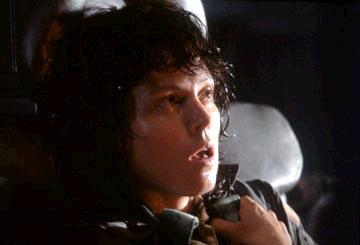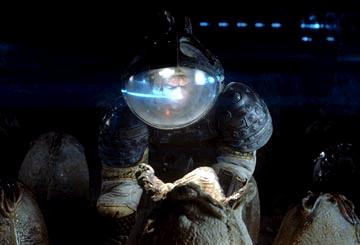

Nearly twenty-five years after its initial 1979 release, Alien returns to scare a new generation of filmgoers with Alien: The Director's Cut. Was a director's cut really necessary? No. This new version adds very little to the original, which is perfectly fine, since the original Alien was, and is still, a great movie. The best part about this re-release is that one can see Alien again on the big screen. More importantly, teenagers, the people that go to the movies most often, can see it how it should be seen. Alien is one of those few films that is genuinely scary, and seeing it on a television does not do it justice. It needs to be seen in a theater, on the huge screen, in the dark, with loud sound. The legacy of Alien is huge. It spawned three sequels (with a spin-off in production and a fifth being bandied about), launched the career of Sigourney Weaver, and redefined the way that space and horror movies were made.
Still, one should mention the new material. The biggest 'new' scene is not that new, having already been included in a release available for purchase, where Ripley (Sigourney Weaver, Holes, Tadpole) discovers the fate of two of her crewmates. Director Ridley Scott (Matchstick Men, Black Hawk Down) originally excised the scene because he believed it slowed down the relentless pacing near the end of the film. Another new scene is where a crewmate confronts and slaps Ripley. The remaining changes were extremely minor and made to help with pacing. Overall, the changes are miniscule, and releasing the film in its original form would have been just as good. What is important is how well Alien stands up (aside from one shot of a computer that looks stupid by today's standards), and looking back one can see how influential it was. In Hollywood, imitation is the best form of flattery, and Alien set the standard for monster/alien films. Films today tend to formulaic; they are unoriginal because they follow the same story done many times before. Movies like Supernova, Event Horizon, and even Jason X are all the same. And what film created the formula? Alien.
The Ripley character was also something different. Here was a strong, confident woman, unafraid to kick ass. It's important to note that screenwriters Dan O'Bannon (Bleeders, Screamers) and Ronald Shusett (Bleeders, Freejack) created the Ripley character such that it could be cast as a man or a woman. Lucky for Weaver it was a woman, since it helped to launch her career. Many of the other actors are still working today, too. From the Dallas (Tom Skerrit, Tears of the Sun, Texas Rangers) and the unlucky Kane (John Hurt, Owning Mahowny, Harry Potter and the Sorcerer's Stone) to the griping crew members Brett (Harry Dean Stanton, Sonny, The Pledge) and Parker (Yaphet Kotto, Two if by Sea, Dead Badge) and the cyborg Ash (Ian Holm, The Fellowship of the Ring, From Hell), nearly every actor involved is still doing work, and many are pretty esteemed. It's a far cry from horror movies today, which pick and choose from attractive young nobodies. Alien attracted actors.
And they acted against a menacing, insect-like alien unlike anything seen before. The alien was designed by Swiss artist H.R. Giger, a man with a seriously twisted mind. Without Giger, Alien loses much of its ability to scare the crap out of audiences. Whereas most space movies depicted an optimistic future and/or clean, modern spaceships, Scott crafted a bleak, blue-collar vision. It was something that audiences could vaguely relate to; being a slave to the grind. Everything was grimy, dirty, the crew argued, and the alien was like something out of their worst nightmares. And, as hard as it was to believe, there was only one. The horror the crew felt was palpable, even twenty years later.